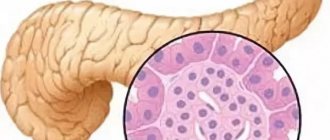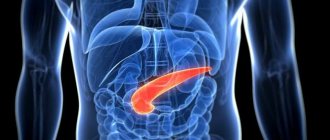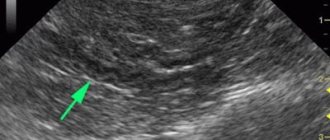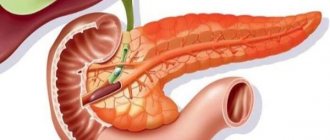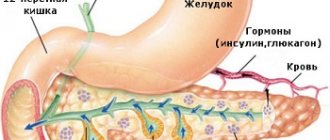Diffusely heterogeneous changes in the structure of the pancreas are not a separate disease, but a reflection of the pathology in the gland identified by ultrasound. These disorders can be caused not only by pancreatic disease, but also by lifestyle, diet, and existing bad habits. A diffusely heterogeneous structure of the pancreas can be detected during functional studies. It is impossible to determine these violations in any other way (laboratory, objective examination).
What is echostructure and echogenicity, indicators are normal
On ultrasound, it is the dense or parenchymal organs that are clearly visualized: liver, spleen, glands, kidneys. Liquid media have the best ultrasonic conductivity, namely the bladder with urine, the gall bladder filled with bile, and blood vessels.
Echostructure is a concept that defines the structure of an organ and the state of its parenchyma at the moment. It can be homogeneous, focally or diffusely heterogeneous. Echogenicity refers to the degree of density of the tissues that make up the gland or other organ being examined. It happens:
- average , or normal (the main landmark is the echogenicity of the healthy liver parenchyma);
- reduced - hypoechoic, when the organ looks “darker” than the liver;
- low (anechoicity), which is typical for the bladder, cysts;
- increased (“lighter” than normal);
- high – hyperechogenic (such echogenicity is comparable to the color of fatty tissue and bones on ultrasound).
A normal (healthy) pancreas may be either homogeneous or somewhat heterogeneous when scanned. Visualization of small or large “grains” in the parenchyma of this organ depends on the level of equipment and the doctor’s sensitivity. If, in the absence of complaints, the structure of the pancreas is diffusely heterogeneous, and the dimensions are within normal limits, then there is no pathology of the organ.
The echogenicity of the pancreas is usually slightly higher or equal to that of the liver. High echogenicity of the gland is established when it is on the same level with the “color” of the fatty tissue. Hypoechogenicity is recorded if the gland is darker than the liver or kidney parenchyma. Thus, normally the pancreas has a fine-grained, somewhat heterogeneous echostructure, medium or increased echogenicity.
Basic methods of diagnosis and treatment
The heterogeneous structure of the liver is diagnosed during a medical examination. The suspected diagnosis can be clarified using the results of functional tests, as well as the results of a biochemical blood test.
Treatment of diffuse changes begins with proper, balanced nutrition. Food should not be too fatty and place increased stress on the organ.
All dishes should be as simple, light and natural as possible, and not contain dyes, preservatives or other chemical components. It is also necessary to stop drinking alcoholic beverages and smoking tobacco.
If heterogeneity in the texture of the liver occurs against the background of increased viral activity, it is recommended to prescribe medications with antiviral effects. In case of changes of bacterial origin, antibacterial therapy is carried out. If a person has fatty liver degeneration, which develops against the background of obesity, it is necessary to normalize your weight and get rid of extra pounds.
An auxiliary element of therapy is the use of multivitamin complexes, immunomodulators, herbal remedies and liver preparations of plant origin. Complex treatment of diffuse changes allows you to normalize the condition and functioning of the organ.
This conclusion from an ultrasound study, such as a diffusely heterogeneous structure of the liver, is a fairly common phenomenon. Many factors can provoke changes in the parenchyma of an organ, and they are not always associated with the development of some disease. To carry out full-fledged therapy to eliminate structural changes in the liver, it is necessary to accurately determine what exactly contributed to the formation of the pathology.
Heterogeneous structure of the pancreas on ultrasound
In adults (especially after 40-45 years), diffuse changes in the organ due to fatty infiltration occur. In this case, the gland will be heterogeneous and the echogenicity will be increased. The dimensions and contours remain normal.
An acute inflammatory process will be indicated not only by the heterogeneity of the echostructure, but also by an increase or sharp decrease in the echogenicity of the organ parenchyma, and an increase in size due to edema. A sharp expansion of the Wirsung duct with thickening of its walls is also possible. In this case, the heterogeneity of the gland will be due to leukocyte or lymphocytic infiltration, expansion of capillaries.
In addition, in acute pancreatitis, the sonologist in the conclusions or in the descriptive part of the protocol may indicate that the pancreas is loose - this means that its contours are unclear, uneven, and its size is significantly increased.
Against the background of chronic pancreatitis, diffuse fibrosis of the pancreas often develops. This is an irreversible process in which normal functionally significant organ tissue is replaced by connective tissue. Fibrous changes in the pancreas give it a “white” appearance. Such an organ has a coarse-grained structure, hyperechoic, and can be reduced in size.
Also, the heterogeneous echostructure of the pancreas may be due to:
- cysts (congenital, post-traumatic, post-inflammatory);
- abscesses, foci of necrosis;
- calcifications, for example, against the background of chronic alcoholic pancreatitis;
- small multiple tumors (insulinomas, apudoms).
Multiple cysts look like small, round, anechoic (black) formations with clear, even contours. Abscesses, on the contrary, have a heterogeneous structure of reduced echogenicity with unclear boundaries, sometimes small hyperechoic inclusions. Calcifications are usually “scattered” throughout the parenchyma of the gland in the form of round or irregularly shaped white formations with a dark track.
Heterogeneous structure in children
In childhood, the pancreas is not an easily visualized organ on ultrasound due to its retroperitoneal location. Its ultrasonic characteristics are also ambiguous.
Thus, in breastfed children during the first year of life it will have reduced echogenicity. If the child is on artificial or mixed nutrition, then the gland is “lighter” and heterogeneous, which is the norm in both cases.
In children, acute pancreatitis occurs much less frequently than in adults, in which the pancreas increases in size due to inflammatory edema and becomes heterogeneous. Its main duct expands in diameter. Over time, hypoechoic areas of necrosis and cysts may appear. This condition requires emergency treatment and diet in a hospital setting.
If a child is diagnosed with insulin-dependent diabetes mellitus, then ultrasound diagnosis of the pancreas is not very informative. This organ remains unchanged for a long time. Only in some cases do doctors record the heterogeneous echostructure of the organ and its reduced size.
Small cysts are often detected in the area of the head or tail of the gland, which give its structure heterogeneity. As a rule, they are monitored dynamically without any surgical treatment. Radical removal of cysts is prescribed if they reach large sizes and cause complications.
What is echogenicity
Echogenicity is the degree of reflectivity of internal organs, based on which doctors can judge the density of living tissues. In this case, the reflectivity of the liver is taken as a standard. The echogenicity of other organs is compared with it, and based on the data obtained, conclusions are drawn about the condition of the tissues. For example, the echostructure of the pancreas should be identical to the corresponding structure of the liver. If the first structure is heterogeneous or differs from the structure of the liver, then this is a reason to contact a gastroenterologist.
Some healthy organs exhibit mixed echogenicity. What does it mean? This means that the organ has heterogeneous density or consists of several types of tissue.
On the monitor of the ultrasound diagnostic machine, all organs are displayed in the form of grainy silhouettes. The specialist conducting the examination can observe that the granularity of the organ is normal or abnormal. Based on this, he can draw conclusions about the condition of the patient’s organs. For example, the finer the image on the monitor, the more reduced the echogenicity of the tissue.
The liver, kidneys, thyroid gland, as well as the human skeleton are quite dense in structure. For this reason, ultrasound waves do not pass through them completely, but are reflected from them. The monitor will display a predominantly coarse-grained image. Sometimes a dense pathogenic formation may appear in the human body, which will reflect almost all ultrasonic radiation. This may be a calcified area of the organ or a stone inside it. In this case, doctors diagnose hyperechogenicity.
Important information: Stones in the pancreas
Many organs have a homogeneous, loose structure, which is why ultrasonic waves pass through them without being distorted. These organs include some glands, as well as the urinary and gallbladder. In a healthy state, they are practically indistinguishable by ultrasound, even if
What pathologies does the heterogeneous structure of the pancreas indicate on ultrasound?
If the doctor simply indicates that the structure of the pancreas is heterogeneous, this means that its fatty transformation has occurred (that is, the amount of fat deposits in the parenchyma has increased).
To make a more serious diagnosis, “diffuse heterogeneity” alone is not enough. The doctor must take into account other ultrasound criteria for various pathologies, and also describe why the structure of the organ has changed.
Causes of diffuse changes in the pancreas
Heterogeneous changes in the structure of the pancreas occur under the influence of various factors. Any deviation from the norm is a dangerous sign. To make an accurate diagnosis and prescribe the correct treatment, it is important to understand the possible causes of organ dysfunction. These include the following list:
- Genetic predisposition.
- Elderly age.
- Pancreatitis in initial or chronic form.
- Metabolic disorders and pancreatic dystrophy.
- Disturbances in the blood supply to this organ.
- Wrong diet.
- Biliary tract dysfunction.
- Bad habits: alcohol, tobacco.
- Stress.
- Hormonal disorders.
- Diabetes.
We also recommend viewing: The main causes and methods of eliminating pancreatic polyps
Some of the reasons cannot be corrected on their own, and they seek help from a doctor. But some of the factors that cause the pancreas to become diffusely heterogeneous can be influenced and eliminated by the patient.
The most common cause of changes in the organ is poor nutrition. An unbalanced diet can significantly impair the functioning of the pancreas. For those who already have problems with this organ, it is better to refrain from salty, spicy, sweet, smoked foods, and add more low-calorie and healthy foods to your diet.
Dependence on alcohol and tobacco also provokes problems with the pancreas. For some people, one cigarette or one glass of wine is enough to cause changes in the organ that will lead to inflammatory processes.
Important. This is explained by the increased susceptibility of the human endocrine system to the slightest negative influences.
The effect of stress on the health of the pancreas can also be controlled and corrected. In most cases, the pancreas is brought into a state of diffuse and heterogeneous changes by psychological trauma and stress that occurs at work or at home, which leads to hormonal imbalances and problems with the endocrine system.
